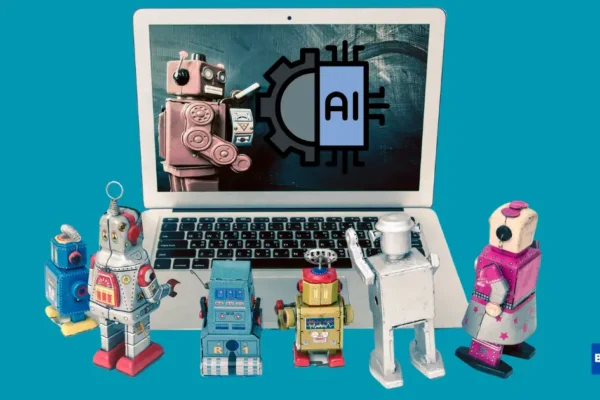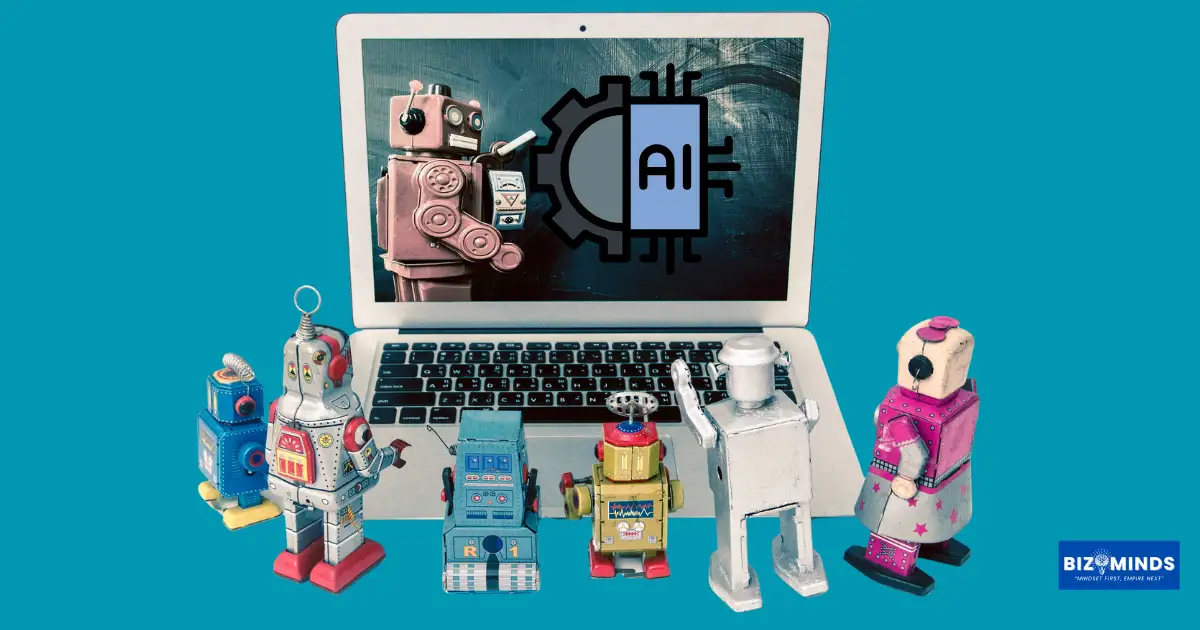

Artificial Intelligence Business Operations Guide 2025: 78% Adoption, $3.70 ROI & Implementation
The structure of American business has transformed dramatically in 2025, as advanced Artificial Intelligence systems reshape operations across every sector. Today’s integration of these digital technologies extends far beyond pilot projects, becoming fundamental to core business infrastructure. Recent data shows that 78% of U.S. organizations now leverage such solutions in at least one function, a sharp rise from just 55% two years ago. This rapid uptake reflects a strategic imperative: companies must harness automation and analytics to achieve measurable outcomes in efficiency, customer satisfaction, and competitive positioning.
From small enterprises saving over 20 hours per month through streamlined workflows to Fortune 500 firms allocating $109.1 billion on AI initiatives, the impact is unmistakable. Across industries, businesses report an average productivity boost of 40%, while every dollar invested returns $3.70 on average. These gains illustrate a fundamental shift in value creation, as organizations reimagine processes, deepen customer engagement, and accelerate decision cycles using intelligent tools.
What sets 2025 apart is the democratization of these capabilities. Cloud-based platforms and subscription models have lowered barriers to entry, enabling operators—from local retailers to national consultancies—to access cutting-edge automation and data insights without massive upfront budgets. Smaller firms now compete on personalization, agile marketing, and lean operations, often outpacing larger rivals in responsiveness and innovation. This inclusive adoption has sparked a new era where adaptability and creativity matter more than sheer scale.
Far from displacing workers, these technologies often enhance roles and drive job growth. Reports indicate 82% of companies integrating automation have expanded their teams, while 74% plan further hires this year. Employees consistently describe feeling empowered, as routine tasks shift to digital assistants and human expertise focuses on strategy, creativity, and relationship-building. The result is a more engaged workforce enjoying higher job satisfaction alongside improved business performance.
As we look ahead, it’s clear that automated intelligence systems have moved from optional to indispensable. Even sectors once resistant to digital change—like manufacturing, healthcare, and agriculture—now rely on predictive analytics, smart maintenance, and automated quality checks for competitive advantage. The critical question for 2025 isn’t whether to adopt these innovations, but how swiftly and effectively organizations can integrate them into daily operations. Those that succeed will define the future of American enterprise, setting new standards for efficiency, innovation, and customer value.
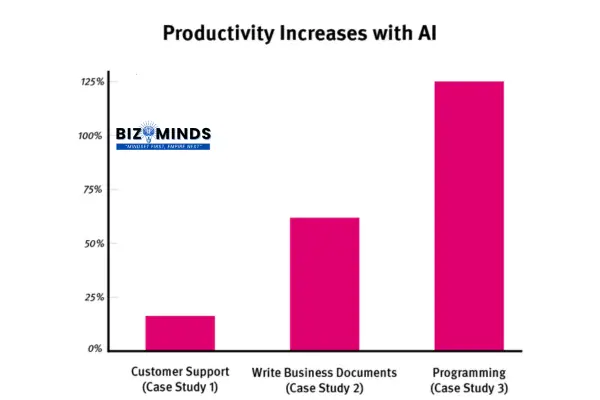
Bar chart showing productivity gains in customer support, business document writing, and programming due to AI integration
The Current State of AI Adoption in American Business
Market Penetration and Investment Landscape
The American Artificial Intelligence market has reached a valuation of $73.98 billion in 2025, positioning the United States as the undisputed global leader in AI investment and innovation. This market dominance becomes even more pronounced when examining private investment flows, where U.S. companies attracted $109.1 billion in 2024—nearly twelve times China’s $9.3 billion and twenty-four times the United Kingdom’s $4.5 billion. The concentration of AI investment in American markets reflects both the maturity of the technology ecosystem and the aggressive adoption strategies employed by businesses across sectors.
Generative Artificial Intelligence represents a particularly dynamic segment, attracting $33.9 billion in private investment during 2024, marking an 18.7% increase from the previous year. This surge in generative AI investment demonstrates the business community’s confidence in advanced AI applications that can create content, generate insights, and automate complex cognitive tasks. The investment trajectory suggests that AI has transcended its experimental phase to become a core component of business strategy and operational planning.
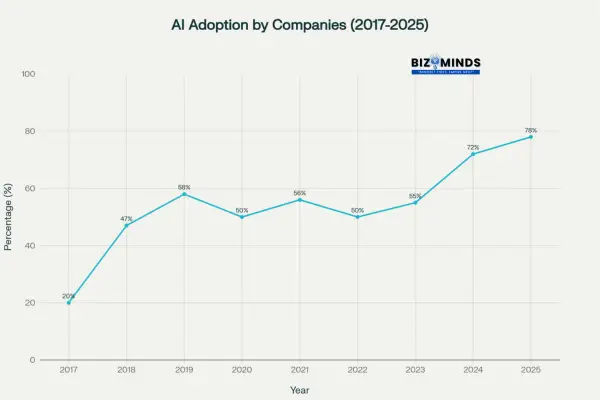
Chart showing the dramatic growth in AI adoption by companies from 20% in 2017 to 78% in 2025
Industry-Specific Adoption Patterns
Different sectors demonstrate varying levels of Artificial Intelligence integration, reflecting both technological readiness and industry-specific value propositions. The technology sector leads with 92% adoption rates, followed closely by financial services at 85%, and retail at 80%. These high-adoption industries share common characteristics: digital-native operations, data-rich environments, and customer-facing processes that benefit significantly from AI automation and personalization.
Manufacturing companies, representing 74% adoption, leverage Artificial Intelligence for predictive maintenance, quality control, and supply chain optimization. By 2035, the manufacturing industry could unlock nearly $3.78 trillion in added value through AI adoption, making it the sector with the highest potential for economic impact compared to all other industries. Healthcare organizations, while showing 67% adoption rates, demonstrate particularly compelling use cases where AI assists in diagnostic accuracy, patient care optimization, and administrative efficiency.
The energy sector, with 68% adoption, employs Artificial Intelligence for grid optimization, predictive maintenance of infrastructure, and renewable energy management. Transportation companies at 71% adoption utilize AI for route optimization, autonomous vehicle development, and logistics coordination. Even traditionally slower-adopting sectors like education show 52% implementation rates, demonstrating the broad applicability of AI solutions across diverse business contexts.
Artificial Intelligence Applications Transforming Business Functions
Customer Service Revolution
Artificial Intelligence has fundamentally transformed customer service operations, enabling 24/7 support capabilities while reducing response times by 35%. American companies deploy sophisticated chatbots and virtual assistants that handle routine inquiries, allowing human agents to focus on complex problem resolution and relationship building. Bank of America’s Erica, an AI-powered virtual assistant, has processed over 1.5 billion customer interactions, demonstrating the scale at which Artificial Intelligence can enhance customer experiences.
The evolution extends beyond simple automated responses to predictive customer service, where Artificial Intelligence systems anticipate customer needs and proactively address potential issues. Companies report 95% accuracy improvements in customer sentiment analysis, enabling more personalized and effective service delivery. This transformation has resulted in customer satisfaction increases of 35% while reducing operational costs by 20-30%.
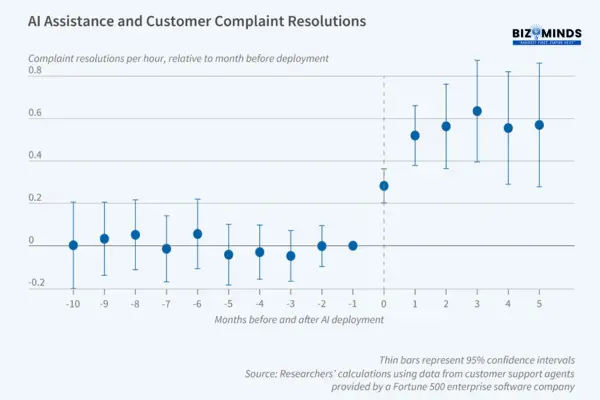
Increase in customer complaint resolutions per hour after AI deployment at a Fortune 500 enterprise
Supply Chain and Operations Optimization
Artificial Intelligence applications in supply chain management have yielded remarkable efficiency gains, with companies reporting 25% reductions in carrying costs and 30% fewer stockouts through predictive analytics. Target and Amazon exemplify this transformation, using AI for demand forecasting, inventory optimization, and automated reordering systems that respond dynamically to market conditions.
Predictive maintenance powered by Artificial Intelligence has become a cornerstone of operational excellence, with companies like Siemens achieving 25% reductions in power outages and saving $750 million annually through AI-driven equipment monitoring. These systems analyze sensor data continuously, identifying potential failures before they occur and scheduling maintenance during optimal windows to minimize disruption.
Manufacturing operations benefit from Artificial Intelligence through quality control systems that achieve 99% accuracy rates while inspecting products 50% faster than human workers.
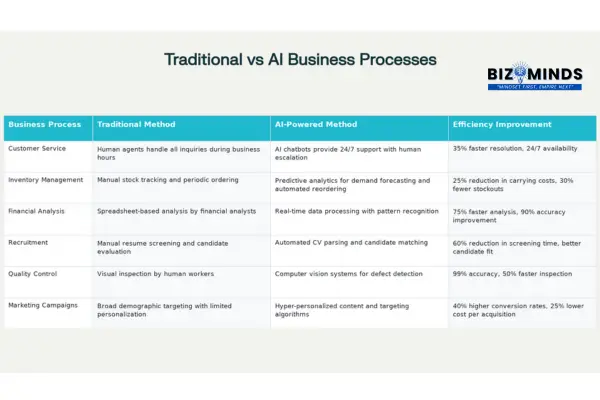
Comprehensive comparison table showing traditional vs AI-powered business processes and their efficiency improvements
Computer vision systems detect defects invisible to human inspection, ensuring consistent product quality while reducing waste and rework costs.
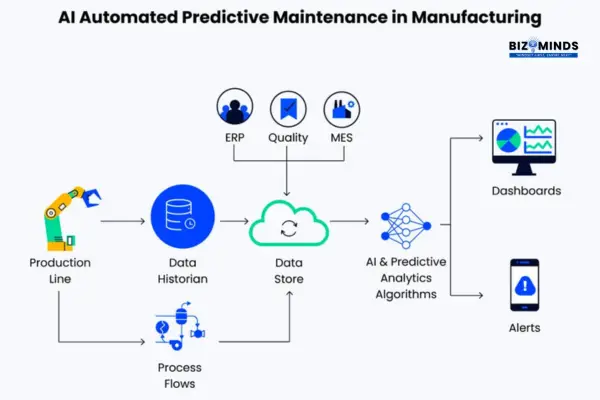
Visual representation of an Artificial Intelligence powered predictive maintenance process in manufacturing, integrating data gathering, AI-driven analysis, and live dashboards with alert systems.
Financial Operations and Risk Management
The financial services sector demonstrates some of the most sophisticated Artificial Intelligence implementations, with JPMorgan Chase leading fraud detection innovations that analyze millions of transactions in real-time. These systems achieve 70% improvements in fraud detection while reducing false positives by 90%, significantly enhancing security while improving customer experience.
AI in financial analysis has accelerated decision-making processes by 75% while improving accuracy by 90%. Algorithmic trading systems execute transactions in milliseconds, optimizing investment strategies and boosting returns through real-time market analysis. Risk modeling and credit scoring applications enable more informed lending decisions while ensuring regulatory compliance through automated reporting systems.
The integration of Artificial Intelligence in financial operations extends to customer-facing applications, where personalized banking recommendations and automated financial planning tools enhance service delivery while reducing operational overhead. These systems process vast amounts of financial data to provide insights that would require extensive human analysis, delivering value to both institutions and customers.
Productivity and Efficiency Gains
Artificial Intelligence Performance Improvements Metrics
American businesses implementing Artificial Intelligence report extraordinary productivity gains across multiple dimensions. Programming and software development tasks show the highest improvement rates at 126%, fundamentally changing how technology teams approach development cycles. Content creation and writing functions demonstrate 50% productivity increases, while data analysis operations improve by 62%.
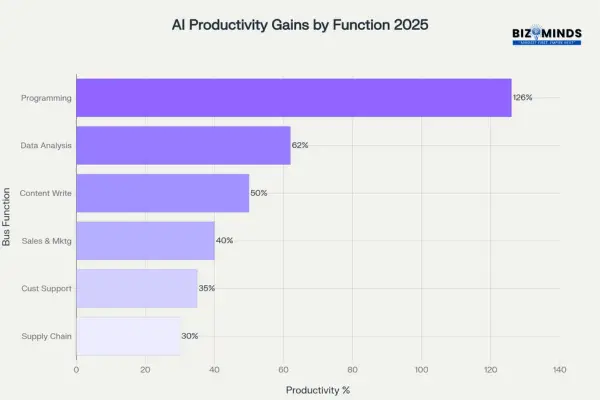
Bar chart illustrating productivity improvements across different business functions with AI implementation in 2025
The average American worker using Artificial Intelligence tools saves 2.5 hours daily, translating to significant cost reductions and improved work-life balance. Small businesses report monthly time savings exceeding 20 hours per employee, with 66% of these organizations saving between $500 and $2,000 monthly through AI implementation. Such savings are often redirected towards growth strategies, technology enhancements, and infrastructure development.
Workforce Impact and Job Creation
Contrary to widespread concerns about job displacement, Artificial Intelligence adoption in American businesses has correlated with workforce expansion rather than reduction. Among small businesses using AI, 82% increased their workforce over the past year, while 74% plan business growth in 2025. This pattern suggests that Artificial Intelligence serves as a productivity multiplier rather than a direct replacement for human workers.
The emergence of new job categories reflects the evolving relationship between Artificial Intelligence and human capability. Positions such as AI ethics specialists, prompt engineers, and AI compliance officers have become increasingly common, with 13% of companies hiring AI compliance specialists and 6% employing AI ethics experts. These roles require uniquely human skills in judgment, creativity, and ethical reasoning that complement AI capabilities.
Fortune 500 companies report that Artificial Intelligence enables employees to focus on strategic, creative, and relationship-building activities while automated systems handle routine tasks. This shift toward higher-value work contributes to job satisfaction improvements, with 90% of workers reporting that AI saves time and 84% stating it makes work more enjoyable.
Industry-Specific Artificial Intelligence Transformations
Manufacturing Excellence
The manufacturing sector represents one of the most dramatic transformations driven by Artificial Intelligence, with the potential to add $3.78 trillion in value by 2035. American manufacturers implement AI across multiple operational areas, from predictive maintenance systems that prevent costly downtime to quality control applications that ensure consistent product standards.
Smart factory initiatives integrate Artificial Intelligence with Internet of Things sensors to create self-optimizing production environments. These systems automatically adjust parameters based on real-time conditions, optimize resource allocation, and schedule maintenance activities to minimize disruption. The result is improved operational efficiency, reduced waste, and enhanced product quality that strengthens competitive positioning in global markets.
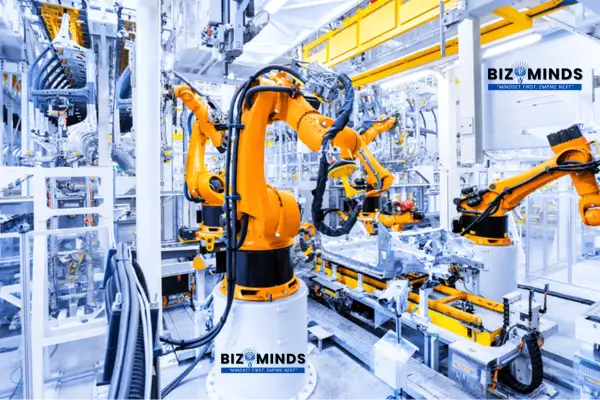
Robotic arms conducting automated manufacturing processes in a state-of-the-art industrial facility in the USA, exemplifying AI-driven business automation
Healthcare Innovation
Healthcare organizations across America leverage Artificial Intelligence to improve patient outcomes while reducing operational costs. The FDA has approved 223 AI-enabled medical devices as of 2023, representing a dramatic increase from just six approvals in 2015. These tools assist physicians in diagnostic accuracy, treatment planning, and patient monitoring while automating administrative tasks that traditionally consumed significant time and resources.
Artificial Intelligence applications in healthcare extend from clinical decision support systems that analyze patient data to predict health risks, to administrative automation that streamlines billing, scheduling, and compliance reporting. Medical professionals report that AI enables more time for patient interaction by reducing documentation burdens and providing rapid access to relevant medical information.
Financial Services Leadership
American financial institutions have emerged as leaders in Artificial Intelligence implementation, driven by regulatory requirements, competitive pressures, and customer expectations for digital services. Beyond fraud detection and risk management, AI powers personalized financial recommendations, automated investment advisory services, and enhanced customer support capabilities.
The integration of Artificial Intelligence in financial services has improved operational efficiency while expanding service accessibility. Automated underwriting processes reduce loan approval times from days to minutes, while AI-powered financial planning tools provide sophisticated advice previously available only to high-net-worth clients. These innovations democratize financial services while maintaining rigorous risk management standards.
Artificial Intelligence Implementation Challenges and Strategies
Overcoming AI Adoption Barriers
Despite the compelling benefits, American businesses face several challenges in Artificial Intelligence implementation. About 42% of small businesses indicate they do not have the required resources and expertise to effectively implement solutions. Of these organizations, 60% cite insufficient expertise in applying AI to their specific business models, while 48% struggle with tool selection and 46% express concerns about data privacy and security.
Large enterprises face different but equally significant challenges, including integration with legacy systems, change management across diverse workforces, and ensuring Artificial Intelligence initiatives align with strategic objectives. Successful implementations require comprehensive planning that addresses technical infrastructure, workforce training, and organizational culture adaptation.
Strategic Implementation Approaches
Companies achieving the most successful Artificial Intelligence implementations follow structured approaches that begin with clear business objectives and progress through systematic deployment phases. Leading organizations start with pilot projects that demonstrate value and build internal expertise before scaling across broader operations.
The most effective strategies involve cross-functional teams that combine technical expertise with deep business domain knowledge. These teams focus on deploying AI solutions that solve genuine business challenges instead of adopting technology merely for its own sake. Successful companies also invest significantly in workforce training, recognizing that AI effectiveness depends heavily on user adoption and proper utilization.
Change management becomes critical as Artificial Intelligence transforms established workflows and job responsibilities. Organizations that communicate transparently about AI initiatives, provide comprehensive training, and involve employees in solution design achieve higher adoption rates and better outcomes than those that implement technology without adequate stakeholder engagement.
Economic Impact and ROI Analysis
Return on Investment Metrics
American businesses implementing AI solutions report impressive return on investment figures, with an average ROI of $3.70 for every dollar invested. Healthcare organizations demonstrate particularly strong returns at $3.20 per dollar invested, while companies using generative AI report similar $3.70 returns. These figures reflect both direct cost savings and revenue enhancements enabled by AI capabilities.
Cost reduction represents a primary driver of Artificial Intelligence ROI, with organizations reporting 20-30% operational cost decreases through automation and efficiency improvements. Error reduction rates of 85% contribute to these savings by minimizing rework, reducing compliance risks, and improving customer satisfaction. Decision-making speed improvements of 75% enable faster response to market opportunities and operational challenges.
Revenue Generation and Growth
Beyond cost savings, AI drives revenue growth through enhanced customer experiences, new product capabilities, and market expansion opportunities. Netflix’s recommendation system generates $1 billion annually by improving content engagement and reducing subscriber churn. Amazon’s AI-driven recommendation system generates 35% of its total revenue, highlighting the significant impact of personalized customer experiences on sales.
Companies leveraging Artificial Intelligence report average revenue growth rates of 25% compared to peers that have not adopted these technologies. This growth stems from improved customer acquisition, enhanced customer lifetime value, and the ability to identify and capitalize on market opportunities more rapidly than competitors.
Future of Artificial Intelligence in Business Operations
Emerging AI Technologies Integration
Next-Generation Agentic AI Systems
The Artificial Intelligence landscape continues evolving at breakneck speed, with agentic AI systems representing the most significant breakthrough since generative AI’s mainstream adoption. These autonomous agents, capable of performing complex multi-step tasks without human intervention, will fundamentally reshape business automation by 2026. Unlike current AI tools that require specific prompts and guidance, agentic systems can independently plan, execute, and adapt their approaches to achieve business objectives across extended timeframes.
In practice, these advanced Artificial Intelligence agents will revolutionize contract management by autonomously negotiating terms, conducting due diligence, and managing approval workflows that currently consume weeks of human effort. JPMorgan Chase has already begun piloting agentic AI for investment research, where systems independently analyze market conditions, generate investment hypotheses, and present actionable recommendations to portfolio managers. Similarly, procurement departments will deploy autonomous agents that can identify suppliers, negotiate pricing, manage vendor relationships, and optimize purchasing decisions based on real-time market conditions and company policies.
The strategic planning applications of agentic Artificial Intelligence promise to democratize high-level business intelligence across organizations of all sizes. These systems will continuously monitor market trends, competitor activities, and internal performance metrics to generate strategic recommendations and scenario analyses that previously required dedicated strategy consulting teams. Small businesses particularly stand to benefit, as agentic AI will provide Fortune 500-caliber strategic insights without the associated consulting costs.
Extended Reality and Immersive Business Experiences
The convergence of Artificial Intelligence with extended reality (XR) technologies—encompassing virtual reality (VR), augmented reality (AR), and mixed reality (MR)—is creating unprecedented opportunities for business transformation. Training programs enhanced with AI-powered XR environments achieve 75% faster skill acquisition compared to traditional methods, while reducing training costs by up to 60%. Walmart has deployed VR training modules powered by AI for over 1.5 million employees, creating personalized learning experiences that adapt to individual learning styles and performance levels.
Customer service applications represent another frontier where AI and XR converge to create revolutionary experiences. Virtual showrooms powered by AI recommendation engines enable customers to visualize products in their own environments while receiving personalized guidance from AI assistants. Home Depot’s AR application, enhanced with AI, helps customers visualize renovations and automatically generates shopping lists with personalized product recommendations, resulting in 40% higher conversion rates compared to traditional online shopping experiences.
Manufacturing operations benefit tremendously from AR interfaces powered by Artificial Intelligence that provide real-time guidance to workers on assembly lines. These systems overlay digital instructions directly onto physical components while AI algorithms monitor quality and suggest optimizations. Boeing uses such systems in aircraft assembly, reducing production errors by 35% while accelerating worker training by 50%.
Autonomous Business Process Orchestration
The integration of Artificial Intelligence with robotic process automation (RPA) and business process management (BPM) platforms is creating autonomous business ecosystems that self-optimize and adapt to changing conditions. These integrated systems will monitor end-to-end business processes, identify bottlenecks or inefficiencies, and automatically implement improvements without human intervention.
Financial services firms are pioneering autonomous loan processing systems that combine AI risk assessment with automated document processing and decision-making workflows. These systems can process loan applications from initial submission to final approval in under 30 minutes for qualified applicants, while maintaining rigorous compliance standards and risk management protocols. The technology scales to handle volume fluctuations automatically, adding or reducing processing capacity based on real-time demand.
Supply chain orchestration represents another area where autonomous AI systems will transform operations. These platforms will continuously monitor supplier performance, market conditions, and demand forecasts to automatically adjust procurement strategies, reroute shipments, and optimize inventory levels across multiple locations. Amazon’s fulfillment network already employs early versions of such systems, automatically coordinating millions of daily decisions across warehouse operations, transportation networks, and delivery logistics.
Regulatory and Ethical Considerations in Business AI
Evolving Compliance Frameworks and Standards
As Artificial Intelligence becomes ubiquitous in business operations, regulatory frameworks are rapidly developing to ensure responsible implementation and fair competition. The Biden Administration’s Executive Order on AI has established new requirements for companies developing or deploying AI systems above certain capability thresholds, mandating safety testing, security assessments, and transparency reporting. American businesses must now navigate complex compliance requirements that span federal, state, and industry-specific regulations while maintaining competitive advantages through innovation.
The Securities and Exchange Commission (SEC) has begun requiring public companies to disclose material AI risks and investments in their 10-K filings, treating AI as a significant business factor that investors must understand. Financial services firms face additional oversight from the Federal Reserve and other banking regulators who are developing AI governance standards for risk management, algorithmic bias prevention, and customer protection. Healthcare organizations must comply with HIPAA extensions that specifically address AI processing of protected health information, while maintaining FDA compliance for AI-enabled medical devices.
Industry-specific standards are emerging rapidly, with the National Institute of Standards and Technology (NIST) releasing comprehensive Artificial Intelligence Risk Management Framework guidelines that many sectors are adopting as best practices. These frameworks require organizations to implement systematic approaches to AI development, testing, deployment, and monitoring that demonstrate responsible innovation and ethical considerations.
Organizational Governance and Responsible AI Practices
The focus on responsible Artificial Intelligence practices has catalyzed significant organizational changes, with 13% of companies now employing dedicated AI compliance specialists and 6% hiring AI ethics experts to navigate the complex landscape of responsible innovation. These roles encompass developing internal AI governance policies, conducting algorithmic audits, and ensuring AI systems align with corporate values and regulatory requirements.
Chief AI Officers have emerged as critical executive positions, with responsibilities extending beyond technology implementation to include strategic oversight of AI ethics, regulatory compliance, and stakeholder communication. These executives typically oversee cross-functional AI governance committees that include legal, compliance, human resources, and business unit representatives to ensure comprehensive oversight of AI initiatives.
Algorithmic impact assessments have become standard practice for companies deploying Artificial Intelligence in hiring, lending, healthcare, and customer service applications. These assessments evaluate potential biases, fairness concerns, and unintended consequences before system deployment, with ongoing monitoring to ensure continued compliance and ethical performance. Companies like Microsoft and Google have established internal review boards that function similarly to institutional review boards in research settings, providing independent oversight of AI development and deployment decisions.
Data Privacy and Security in the AI Era
Privacy and security concerns have intensified as Artificial Intelligence systems process unprecedented volumes of sensitive business and customer data. The California Consumer Privacy Act (CCPA) and similar state-level regulations now include specific provisions for AI processing, requiring companies to disclose how personal information is used in automated decision-making systems and providing consumers with rights to opt-out of certain AI processing activities.
Data governance frameworks have evolved to address AI-specific challenges, including requirements for data lineage tracking, model explainability, and audit trails that demonstrate compliance with privacy regulations. Organizations must now implement technical safeguards such as differential privacy, federated learning, and homomorphic encryption to protect sensitive information while enabling AI innovation.
Cybersecurity considerations for Artificial Intelligence systems extend beyond traditional data protection to include model security, adversarial attack prevention, and AI-specific threat detection. Companies are investing in AI security platforms that can identify attempts to manipulate or poison AI training data, detect model theft or reverse engineering attempts, and monitor for unusual AI system behavior that might indicate compromise.
Building Sustainable AI Business Practices
The development of sustainable Artificial Intelligence practices encompasses both environmental and social responsibility considerations. Energy consumption by AI systems has become a significant concern, with large language models requiring substantial computational resources for training and operation. American companies are increasingly adopting carbon-neutral AI initiatives, optimizing model efficiency, and selecting cloud providers committed to renewable energy sources.
Transparency and explainability requirements are driving the adoption of interpretable Artificial Intelligence models, particularly in regulated industries where decision-making processes must be auditable and understandable to stakeholders. Financial institutions, healthcare organizations, and government contractors are implementing AI systems that can provide clear explanations for their recommendations and decisions, enabling human oversight and regulatory compliance.
Stakeholder engagement has become essential for successful AI implementation, with companies conducting regular consultations with employees, customers, and community representatives to understand concerns and gather feedback on AI initiatives. This inclusive approach helps identify potential issues early and builds trust in AI systems through transparent communication and responsive governance.
The future success of Artificial Intelligence in American business operations will depend not only on technological advancement but also on the ability of organizations to implement these powerful tools responsibly, ethically, and in compliance with evolving regulatory frameworks. Companies that establish robust governance structures, invest in responsible AI practices, and maintain focus on stakeholder value creation will build sustainable competitive advantages while contributing to the positive transformation of the American economy through intelligent technology adoption.
Conclusion
The revolution of business operations through Artificial Intelligence represents more than technological advancement—it signifies a fundamental transformation in how American enterprises create value, serve customers, and compete globally. The data clearly demonstrates that AI has moved beyond experimental applications to become essential business infrastructure, with 78% of U.S. organizations now implementing these technologies across critical operational areas.
The impact extends across every sector of the American economy, from manufacturing organizations saving millions through predictive maintenance to financial institutions processing millions of transactions with unprecedented accuracy and speed. Small businesses report significant time and cost savings, while Fortune 500 companies achieve competitive advantages through sophisticated Artificial Intelligence applications that would have been inconceivable just years ago.
The productivity gains—ranging from 35% improvements in customer service to 126% increases in programming efficiency—demonstrate that AI serves as a powerful multiplier of human capability rather than merely an automation tool. These improvements translate directly to business outcomes: higher customer satisfaction, reduced operational costs, and accelerated decision-making that enables rapid response to market opportunities.
Perhaps most significantly, the evidence suggests that Artificial Intelligence adoption correlates with job creation rather than displacement. Companies implementing these technologies report workforce expansion and job satisfaction improvements as employee transitions from routine tasks to higher-value strategic work. This pattern indicates that AI can enhance human potential rather than replace it, creating opportunities for meaningful career development and business growth.
The investment trajectory with $109.1 billion in private AI investment flowing to American companies—signals continued acceleration in Artificial Intelligence adoption and innovation. As costs continue declining and capabilities expand, even more organizations will integrate these technologies into their operations, creating a compounding effect that will reshape competitive dynamics across industries.
Looking forward, the organizations that embrace AI systematically, invest in workforce development, and maintain focus on customer value creation will establish lasting competitive advantages. Those that delay adoption risk falling behind in an increasingly AI-driven economy where efficiency, personalization, and rapid adaptation become essential for success.
The revolution is not coming, it is here. American businesses that recognize this reality and act decisively to integrate Artificial Intelligence into their operations will thrive in the transformative landscape of 2025 and beyond. The evidence overwhelming supports one conclusion: AI has become indispensable for business success in the modern American economy.
Frequently Asked Questions
1. What percentage of American businesses are currently using AI in 2025?
Recent surveys reveal that by 2025, 78% of U.S. companies utilize Artificial Intelligence in at least one business function, marking a notable rise from 55% in 2023. Specifically, 71% of organizations have integrated generative AI technologies into one or more business areas. Small and medium businesses show 58% adoption rates, while Fortune 500 companies demonstrate even higher implementation levels approaching 90% in many sectors.
2. How much return on investment can businesses expect from AI implementation?
American businesses report an average ROI of $3.70 for every dollar invested in Artificial Intelligence solutions. Healthcare organizations show particularly strong returns at $3.20 per dollar invested, while companies using generative AI report similar $3.70 returns. The investment in Artificial Intelligence typically pays back through 20-30% operational cost reductions, 85% error reduction rates, and 25% average revenue growth compared to non-adopting competitors.
3. Which business functions show the highest productivity gains from AI?
Programming and software development demonstrate the highest productivity improvements at 126% increase with Artificial Intelligence implementation. Data analysis functions show 62% productivity gains, while content creation and writing improve by 50%. Customer service operations report 35% efficiency improvements, and supply chain management sees 30% productivity increases. Marketing and sales functions, used by 71% of companies, show significant improvements in campaign effectiveness and customer targeting.
4. What are the primary challenges companies face when adopting AI technologies?
The primary challenges include lack of specialized expertise (reported by 60% of struggling organizations), difficulty selecting appropriate tools (48% of businesses), and concerns about data privacy and security (46%). Additionally, 42% of small businesses report lacking access to necessary resources for successful Artificial Intelligence deployment. Integration with existing systems, change management across workforces, and ensuring alignment with strategic objectives represent additional significant challenges for larger enterprises.
5. How is AI affecting employment in American businesses?
Defying fears of job loss, 82% of small businesses leveraging Artificial Intelligence have expanded their workforce over the past year. Among companies implementing AI, 74% plan business growth in 2025, creating new job opportunities. Artificial Intelligence has created new roles such as AI ethics specialists (hired by 6% of companies), AI compliance officers (13% of companies), and prompt engineers. The technology enables workers to focus on higher-value strategic tasks while automated systems handle routine work.
6. What industries are leading in AI adoption in the United States?
The technology sector leads with 92% Artificial Intelligence adoption rates, followed by financial services at 85%, and retail at 80%. Manufacturing leads AI adoption at 74%, with an anticipated economic benefit of $3.78 trillion by 2035. Meanwhile, healthcare shows a 67% adoption rate, supported by 223 FDA-approved AI-enabled medical devices as of 2023. Transportation (71%), energy (68%), and even education (52%) show significant adoption rates across their operations.
7. How much time and cost savings can businesses expect from AI implementation?
American workers using Artificial Intelligence tools save an average of 2.5 hours daily. Small businesses report saving over 20 hours per employee each month, with 66% achieving monthly cost savings ranging from $500 to $2,000 through AI adoption. Companies report 20-30% operational cost reductions, 75% faster decision-making, and 35% improvements in customer satisfaction. These savings typically get reinvested in growth initiatives and technology infrastructure improvements.
8. What specific AI applications are most common in American businesses?
Customer service chatbots and virtual assistants are used by 46% of businesses implementing Artificial Intelligence. Marketing and sales AI applications show 71% adoption rates for personalization and targeting. Supply chain optimization (43% usage) includes demand forecasting and inventory management. IT operations automation (36% adoption) covers system monitoring and maintenance, while software engineering tools (41% usage) assist in code generation and testing.
9. How much are American companies investing in AI technologies?
In 2024, U.S. private AI investment surged to $109.1B—almost 12x China’s $9.3B—while the American AI market is valued at $73.98B in 2025 and the global market is forecast to reach $1.85T by 2030. Generative AI secured $33.9B in private funding (up 18.7% YoY), and worldwide corporate AI spending hit $252.3B with the U.S. leading the pack.
10. What are the key success factors for AI implementation in businesses?
Successful Artificial Intelligence implementations require clear business objectives aligned with strategic goals, comprehensive workforce training programs, and cross-functional teams combining technical and domain expertise. Companies achieving the best results start with pilot projects to demonstrate value before scaling across operations. Strong data governance frameworks, transparent communication about AI initiatives, and systematic change management processes ensure higher adoption rates and better outcomes.
11. How is AI transforming customer service operations?
Artificial Intelligence enables 24/7 customer support through sophisticated chatbots and virtual assistants, with companies reporting 35% faster resolution times. Bank of America’s Erica has processed over 1.5 billion customer interactions, demonstrating the scale of AI customer service. Predictive customer service anticipates needs and proactively addresses issues, resulting in 35% customer satisfaction increases and 95% accuracy improvements in sentiment analysis. Companies achieve these improvements while reducing operational costs by 20-30%.
12. What does the future hold for AI in American business operations?
The Artificial Intelligence landscape continues evolving toward agentic AI systems that can perform complex multi-step tasks autonomously, representing the next frontier in business automation. Integration with extended reality (XR) technologies will create immersive training and customer experiences. As regulatory frameworks develop, companies must balance innovation with responsible AI practices. The trend toward smaller, more efficient AI models will make these technologies accessible to even more businesses, while continued cost reductions and capability improvements will drive further adoption across all sectors of the American economy.


